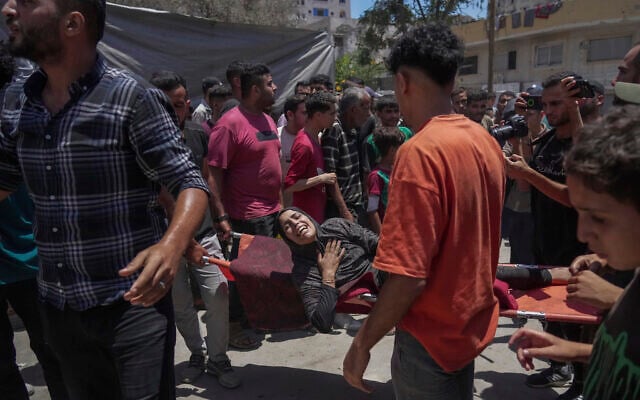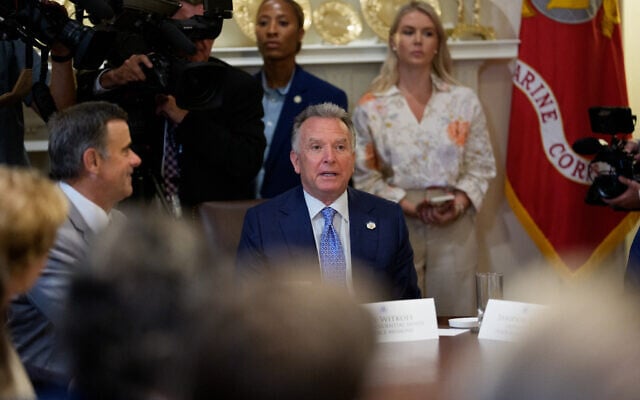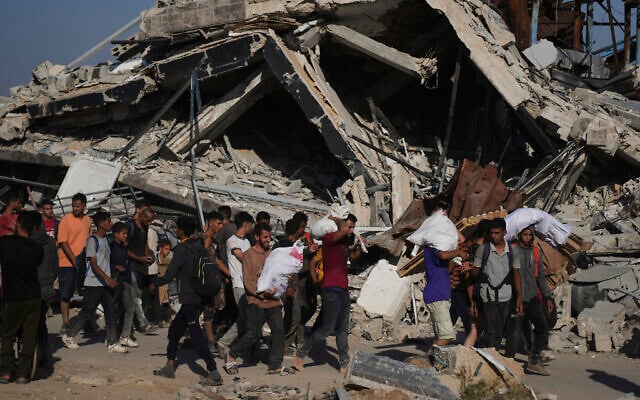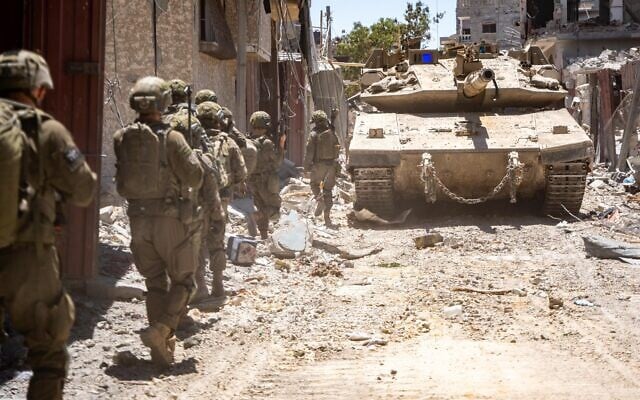


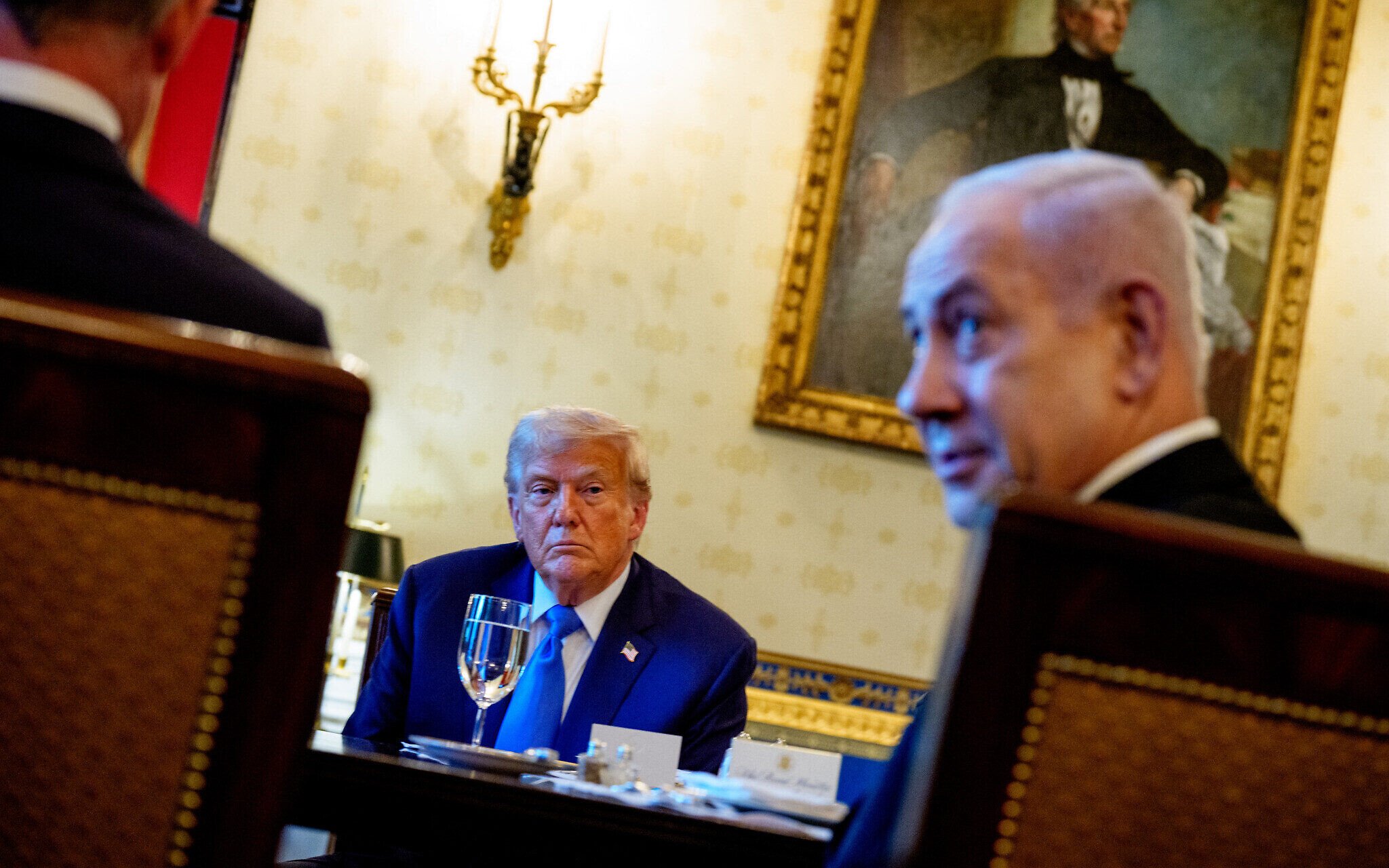
WASHINGTON — The Trump administration has assured mediators that it does not intend to allow Jerusalem to resume fighting against Hamas in Gaza following a 60-day ceasefire, even if not explicitly included in the text of a deal being hashed out in Washington and Qatar, an Arab diplomat and a second source familiar with the matter told The Times of Israel on Wednesday.
The issue of whether Israel will be able to restart its military campaign at the conclusion of a proposed 60-day ceasefire and the release of hostages is one of the main sticking points in talks that have failed to produce a breakthrough even as leaders continued to express optimism that one could be reached.
In the Oval Office, US President Donald Trump told reporters “We’re getting very close to a deal on Gaza.” That came after Prime Minister Benjamin Netanyahu told American TV said there was a “good chance” to reach a deal and Foreign Minister Gideon Sa’ar said he thought an agreement to end 21 months of bitter fighting was “achievable.”
According to the Arab diplomat, Israel’s submission of a revised map of its military pullout from Gaza during the truce had moved the sides closer to a deal.
At the same time, Israel’s military said it was expanding its offensive in northern Gaza’s Beit Hanoun, where the military estimates dozens of Hamas operatives are holed up in tunnels. And sources close to Hamas indicated that talks had failed to progress, blaming Israel.
The Israeli delegation is “mostly listening rather than negotiating, which reflects Netanyahu’s ongoing policy of obstruction and sabotaging any potential agreement,” a Palestinian source familiar with the negotiations told AFP.
Israel has insisted that any deal include the option of the war resuming once 60 days have passed, while the Hamas terror group has sought a formulation in which the ceasefire would pave the way to a permanent end to the war.
Despite opposing an Israeli resumption to the war, the US does not want that possibility ruled out in the text of the ceasefire proposal, the Arab diplomat and the second source said. The possibility of a return to war is seen as essential leverage against Hamas during talks on the terms of a permanent ceasefire.
Moreover, explicitly instituting a permanent ceasefire in the text of the proposal would lead to the collapse of Netanyahu’s government, the source familiar with the negotiations said, indicating that the mediators are trying to avoid such a scenario in order to keep the Israeli premier on board.
Netanyahu’s far-right coalition partners have pledged to bolt the coalition if Israel agrees to provide an up-front commitment to end the war; the Israeli premier himself has long rejected this possibility.
The proposal crafted by US, Egyptian and Qatari mediators and backed by Jerusalem stipulates that Israel and Hamas will hold talks on the terms of a permanent ceasefire during the temporary truce, which will remain in place past the two-month benchmark so long as the sides are still negotiating in “good faith.”
Hamas in its July 4 response to the ceasefire proposal sought to remove the “good faith” clause, viewing it as a window for Israel to resume the war after the 60-day truce expires, as it did at the conclusion of the previous ceasefire’s initial truce phase in March.
While Washington opposes removing the language, US special envoy to the Mideast Steve Witkoff has passed along a verbal assurance through mediators that US President Donald Trump will personally guarantee that the truce will remain in place until agreements on a permanent ceasefire are reached, the two sources said.
Netanyahu pledged again Tuesday to “finish the job” against Hamas, indicating that he would seek to resume the war and continue dismantling the terror group’s hold on Gaza after the 60-day truce. He says he is prepared to end the war if Hamas gives up its weapons and its leaders go into exile — conditions that the group has long rejected.
The prime minister has also conditioned an end to the war on the implementation of Trump’s controversial plan to take over Gaza and encourage the mass migration of its Palestinians.
Trump has spoken less about the plan after introducing it in February, sparking widespread pushback from the international community. But Netanyahu and other Israeli leaders have embraced the “voluntary migration” idea, which critics have said is a euphemism for the ethnic cleansing of Gaza, given that the premier has reportedly told lawmakers that Israel is working to destroy every building in the Strip so Palestinians have nowhere to go after the war but outside of the enclave.
The Gaza deal under discussion would see the release of 10 living hostages and the remains of 18 more in five groups throughout the two-month truce, in exchange for a yet-to-be-agreed-upon number of Palestinian security prisoners.
Israeli and Hamas negotiating teams have been holding proximity talks in Doha since Sunday, but have yet to discuss the identities of those to be released as part of the deal, with Hamas insisting that other issues be solved first.
Sources say the extent of Israel’s military pullback from Gaza during the truce and the mechanism by which aid will enter the Strip are also remaining points of contention.
The two sources said Wednesday that Israel had submitted a new set of maps to mediators in Doha detailing the partial withdrawal of IDF troops during the 60-day truce under discussion, following pressure from the US to limit Israeli presence in the Strip.
The previous proposed partial withdrawal from Gaza had been rejected by Hamas, and the issue has become the main sticking point in the negotiations, the sources said.
Israel has insisted that it remain in the Morag Corridor in southern Gaza, a belt of land cutting off the cities of Rafah and Khan Younis from each other. Israel says it plans to create a “humanitarian city” between the Morag Corridor and Philadelphi Corridor south of Rafah where the Strip’s entire population will be herded and prevented from leaving once vetted.
Hamas has sought a more comprehensive Israeli pullback matching its retreat during a previous ceasefire in January.
The sources didn’t say whether Israel has now dropped the demand, but the Arab diplomat said the updated Israeli maps brought the sides closer to a deal.
The US pressure for Israel to ease its stance on the matter came during a meeting Witkoff held with a visiting Qatari delegation at the White House on Tuesday afternoon, which Strategic Affairs Minister Ron Dermer joined, the Arab diplomat said.
Regarding the issue of aid, negotiators in Doha offered initial backing for clauses in the agreement that would prevent the Gaza Humanitarian Foundation from operating in areas from which the IDF has withdrawn, a source familiar with the negotiations told The Times of Israel on Tuesday.
Only the UN and international organizations that are not connected to either Israel or Hamas will be responsible for distributing aid in areas where the IDF is no longer located, the source said.
GHF has been criticized for setting up distribution sites in areas controlled by the IDF, forcing Gazans to walk long distances while crossing military lines — often coming under deadly fire as a result — in order to pick up boxes of food. Israel says the mechanism is necessary to prevent Hamas from diverting aid.
The White House said Witkoff would travel to the region this week in order to advance the negotiations in Doha, but two sources familiar with the matter told The Times of Israel on Tuesday that the Trump envoy had pushed back a planned Tuesday departure, indicating that the talks weren’t yet ripe enough for his arrival to close the deal.
Two Arab diplomats from mediating countries said Tuesday that Egypt and Qatar weren’t as optimistic as the US has been regarding the chances for a deal. Both Trump and Witkoff have said a deal could be reached this week.
Netanyahu and Trump met for a second time on Tuesday, raising hopes for an announcement, but the Israeli premier left the White House without making any statement on a deal.
Netanyahu is in the US until Thursday, but no further meetings were planned between the two, a member of Netanyahu’s entourage told The Times of Israel on Wednesday.
“If such a meeting is needed, it will be arranged,” the official said.
Regarding talks in Doha, the official said that “all the sides are interested in an agreement for a ceasefire. We are making efforts and trying to reach one.”
A senior Israeli official had told reporters on Monday that Hamas’s July 4 response to the latest ceasefire proposal moved the sides backward and that more than a few days might be needed to reach an agreement.
But in an interview with Fox Business on Wednesday, Netanyahu expressed optimism.
“I think we’re getting closer to a deal,” he said ahead of a meeting with Defense Secretary Pete Hegseth at the Pentagon.. “There’s a good chance that we’ll have it.”
In Slovakia, Sa’ar said Israel would negotiate a permanent ceasefire with Hamas in the Gaza Strip if an agreement is reached on a temporary truce.
“Israel is serious in its intent to reach a hostage deal and a ceasefire in Gaza. I believe it is achievable,” Sa’ar said during a joint press conference alongside his Slovak counterpart Juraj Blanár.
He denied that Israel was pointlessly prolonging the war, saying, “We are committed to our war objectives — but war itself is not our objective. We always prefer to achieve our goals through diplomatic means. But it must be clear: Hamas is not only responsible for initiating this war, but also for its continuation. Pressure must be applied to Hamas.”
Lazar Berman and Nava Freiberg contributed to this report.

